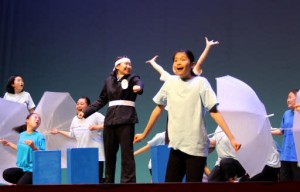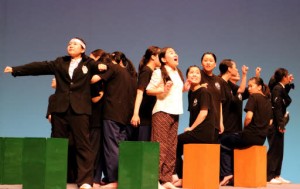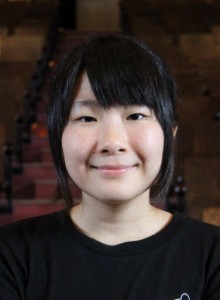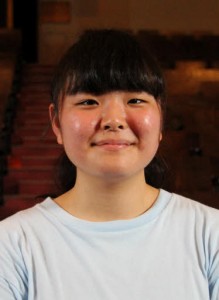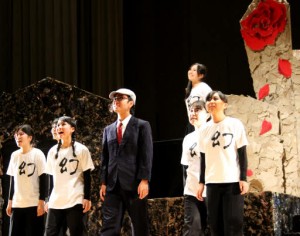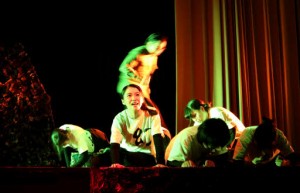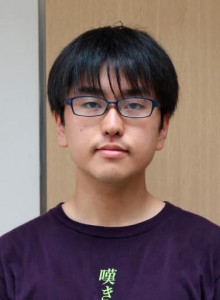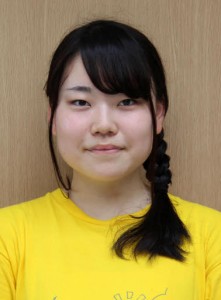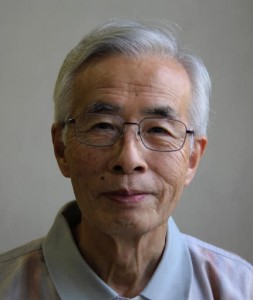Peace Seeds: Teens in Hiroshima Sow Seeds of Peace (Part 47)
Aug. 17, 2017
A-bomb plays performed by high school students in Hiroshima
A growing number of drama clubs are performing plays about war and peace at high schools in Japan. This development may be inspired by efforts that began in Hiroshima. In the summer that marks the 72nd anniversary of the atomic bombing, junior writers from the Chugoku Shimbun visited two high school drama clubs in the city: Funairi High School in Naka Ward and Numata High School in Asaminami Ward. These two clubs are carrying on the tradition, begun by alumni of their schools, of performing plays about the A-bombing. During our visits, we watched the students rehearse and then saw their live performances. Through these performances, put on by young people of our generation, we were able to touch the suffering of the A-bomb survivors and the dynamic time of reconstruction that took place after the war. A-bomb plays by high school students are serving as a vehicle for students to reflect on Hiroshima and the war from the viewpoint of teens as well as convey the A-bomb experience to others.
Students from Numata High School perform “Kaze no Densha” (“Streetcar in the Wind”)
On August 5, the drama club at Numata High School performed the play “Kaze no Densha” (“Streetcar in the Wind”) at the Hiroshima Green Arena in Naka Ward, where an event called “Peace Action in Hiroshima” was taking place. This is an original play based on the story of a female student who was working as a streetcar driver on the day of the atomic bombing because there was a shortage of labor during the war.
Natsue Fujikawa, the main character, wants to do her best as a driver, out of devotion to what she believes is a divine nation. She works hard so she can drive the streetcar well when one day her mother and younger sister, her closest loved ones, are on board with her. However, her mother and sister are killed when Hiroshima is attacked with the atomic bomb. Natsue blames herself for having survived the bombing, while the passengers on board her streetcar perish, and she loses her will to continue driving. But by the end of the play, with the resolve to move forward, she drives the first streetcar that operates in the aftermath of the disaster.
The members of the club, which began to perform A-bomb plays seven years ago, have discussed their choice of play each year, considering whether or not the atomic bombing would be their theme. “Drama is able to make audiences think about issues in society or in the local community. A-bomb plays are one example of drama fulfilling this role,” explained Seiji Matsumoto, 54, a teacher at the school and the club’s advisor.
Miu Matsukage, 17, a second-year student who played the role of Natsue’s younger sister, said, “Plays put on by high school students are unique because the performers are so dynamic on stage. I feel a sense of mission in my performance, rather than a heavy responsibility.” In the scene where the first streetcar is running after the bombing, like a ray of hope, the whole cast was on stage and singing a powerful song while making full use of their bodies to convey the moment. It was a moving experience to feel the passion of the survivors who were able to endure and rebuild the city of Hiroshima. (Aoi Nakagawa, 16)
Hikari Kannan, actress who played the main character
Hikari Kannan, 16, a second-year student, played the role of the main character. To prepare for her role, she said that she read books and looked at photos so she could know what people ate during the war and what sort of things were popular at that time. She took that approach because she wanted to understand the real history and feel a spirit of empathy for the people. Though their audiences have had mixed reactions to the A-bomb play, Ms. Kannan said firmly, “We have to continue performing it.” She feels this way because of her concern over the fact that younger generations take no interest in issues of war and peace, and she wants to convey to them the message that war must never be waged.
Through her participation in the drama club, Ms. Kannan has also become more interested in parts of the world suffering conflict, like Syria. She said, “The happy lives we live now are built on the efforts made by the people that came before us. I’d like others to appreciate that peace isn’t something we can take for granted and that they can make a difference by delivering a message like this to others in the world.” When she was driving the streetcar in the play, after the bombing, she stood tall and fixed her eyes straight ahead. I could feel her strong hope for a peaceful world through her spirited performance. (Hiromi Ueoka, 16)
Nanami Hino, main director of the play
Various methods were used in directing the play, too. Nanami Hino, 16, a second-year student, was the main director. She said, “The play is a success if our vision can be conveyed well to the audience. I’ve tried to direct it in a way that helps them understand things as easily as possible.”
The time of day, whether morning or evening, was expressed with changes in the lighting, to orange or to blue. When the atomic bombing took place, the silhouettes of those who were killed in the streetcar were projected onto a background of bright red light, like fire, which was very striking as it enabled me to imagine their tragic fate.
When all the performers sang together, a sense of energy was created by turning umbrellas or shaking pieces of fabric. This had me feeling like I was one of the characters in the play. Ms. Hino told me that the singing and acting was made more dynamic by the group having the common goal of creating the play together and rehearsing hard. I think it’s remarkable that young people of my generation are using drama to convey the A-bomb experience of Hiroshima. I hope their efforts will be handed down to more students in the future. (Hinako Okada, 15)
---------------------------------------------
Students from Funairi High School perform “Ichirin no Hana no Maboroshi (“Illusion of a Single Flower”)
The drama club at Funairi High School has been producing A-bomb plays for nearly 50 years. On August 6, the club members performed an original play titled “Ichirin no Hana no Maboroshi” (“Illusion of a Single Flower”) before an audience of people from many parts of Japan at a peace culture event hosted by the City of Hiroshima at the International Conference Center Hiroshima in Naka Ward. The play depicted the life of Tamiki Hara, a writer and poet who experienced the atomic bombing, including his struggles after the war ended.
In the scene that conveyed the A-bomb blast, there was a female student crawling on the ground and a man who was unable to walk. Immediately, there was a heavy, somber atmosphere in the theater. “Help me,” the student groaned softly. I was sitting in the front row and I felt like she was pleading for my help.
The scene where Mr. Hara recognized the meaning of his existence took my breath away because I could vividly imagine his heartfelt cry. I can still hear the line that was said repeatedly: “I have it.”
Funairi High School was formerly the Hiroshima First Municipal Girls’ School. On the day of the atomic bombing, about 540 first-year and second-year students who were helping to tear down houses to create a fire lane, along with their teachers, were killed. That experience underlies the club’s activities, but each year the members of the club still discuss whether to continue performing A-bomb plays. Yukihiko Suzaki 61, a teacher at the school and the club’s advisor, said, “Some students feel pressured to maintain the tradition of performing A-bomb plays.” During one discussion, a student spoke up by saying, “If we don’t give our hearts to the A-bomb plays, it’s insulting to all the members of the club who’ve come before us.”
Sara Matsuda, 16, a first-year student, stressed, “I’m not sure what the A-bomb survivors would think of our performance, but I want to understand the history more deeply, in my own way, like listening to the survivors’ accounts.” I realized again that peace building activities come in many different forms and it’s fine if I do what I can to make a contribution. (Akane Sato, 14)
Yasutaka Ono, actor who played the main role
Yasutaka Ono, 17, played the role of Tamiki Hara. A second-year student, he said, “I would like everyone to consider not only the historical facts of Hiroshima but the actual people who were living there on August 6, 1945.”
Before the atomic bombing, Mr. Hara’s wife died, which deprived him of the will to live. But after the atomic bombing, he wrote Natsu no Hana (Summer Flowers), his best-known work, in reaction to his A-bomb experience. As Mr. Ono prepared his role for the play, he came to see Mr. Hara as a man whose life was saved by the atomic bombing because the deaths of so many others compelled him to live.
In the scene of the A-bomb blast, Mr. Ono cried out with a voice that seemed to come from the bottom of his heart in order to express Hiroshima, where people were devastated in a flash, both physically and mentally.
The members of the drama club have regularly engaged in dance and other exercises in order to strengthen their physical and mental capacity to express the emotional aspects of their characters. Mr. Ono said, “Our goal is to place highly in the national contest and show this A-bomb play to as many people as possible.” He plans to perform a new play on the atomic bombing in the future, as one of the second-year students, who take a leading role in the club. (Ryoma Iwata, 13)
Ririka Nii, director of the play
“I’m proud to carry on the tradition of the A-bomb plays,” said Ririka Nii, 17, a third-year student. In her efforts as the director, she has emphasized discussions among the club members so they can gain a deeper understanding of Hiroshima’s past. To do the play justice, she feels they must face this history squarely, which is uncommon among younger generations who aren’t familiar with the atomic bombing.
Ms. Nii said that, in particular, she takes into account those members of the audience who are younger than she is. She sees the drama club as a way to convey a perspective of war, and wants the group to be a vehicle for handing down the A-bomb experience to younger generations at a time when memories of the atomic bombing have began to fade.
As the director, Ms. Nii has sought to handle scenes of death and suffering as thoughtfully as possible. As I watched her and the other club members engaged in the play, with their heart and soul, I couldn’t help wonder if I have been as passionate in my own efforts when I’m involved in gathering information and writing articles on the atomic bombing and peace. (Hiromi Ueoka, 16)
Interview with Takahiro Ito, former advisor for the drama club at Funairi High School
We interviewed Takahiro Ito, 78, a resident of Saeki Ward who served as advisor for the drama club at Funairi High School for about 30 years and helped lay the foundation for performances of A-bomb plays in Hiroshima. We asked him about these efforts to date and the significance of A-bomb plays performed by teens.
The drama club at Funairi High School performed its first A-bomb play in 1969. Prior to that point, existing scripts were chosen for their performances. But in 1968, when the club took part in a national drama contest for the first time, one of the members was impressed by the fact that most of the other schools were performing original plays and argued that the club should create its own play on the theme of Hiroshima’s past. This was the beginning of its efforts to produce A-bomb plays.
The first original A-bomb play was titled “Shiroi Canvas” (“White Canvas”). It was the story of a high school student and a second-generation A-bomb survivor who struggled with illness. Inspired by a newspaper article at the time, Mr. Ito came up with the idea and the script. Since then, the club has conveyed Hiroshima’s experience from a variety of perspectives, including the story of peace education lessons taught by a female teacher who experienced the atomic bombing and the story of an A-bombed streetcar. Mr. Ito has written about 30 plays for high school students.
“If the plays focus only on tragedy, they won’t appeal to the audience,” Mr. Ito said. In his eyes, the value of high school students performing A-bomb plays is that this generation, which hasn’t experienced war, can come to understand and identify with the reality of that time and the suffering of the A-bomb survivors. He added that these performances play an important role in handing down the A-bomb experience to others because young audiences can more readily empathize with the young performers.
Because the A-bomb survivors are gradually passing away, such performances are coming to serve an even more important role. If more people knew about A-bomb plays, we believe more schools would become involved in these activities, too. (Aoi Nakagawa, 16, and Miyu Okada, 16)
Junior writers’ impressions
How can we best convey Hiroshima’s experience of the atomic bombing? Because we have no personal experience of the war, and the opportunities to listen to A-bomb survivors’ accounts firsthand are decreasing, it’s not easy to imagine what it was like when people suffered the A-bomb attack. That’s why we have to imagine what we would have felt if we had been there, and reflect on this deeply as an issue that affects us, too. It was the first time for me to see an A-bomb play. When I saw the scenes of happiness or tragedy, I was able to appreciate that the people of that time experienced many things. I think the first step, to prevent the A-bomb experience from fading, involves our resolve to hand down not only the historical facts of the Hiroshima bombing but also the experiences of the people who were actually there. (Ryoma Iwata)
In writing this article, it was the first time I saw an A-bomb play. Both the dress rehearsal and the live performance were so powerful, I got chills a number of times and I thought, with regret, that I should have seen a play like this sooner. I sat in the front row as I watched the students from Funairi High School perform their play. When a female student in the play groaned softly, “Help me,” I felt like she was asking me for help, but all I could do was continue watching her. I’m sure that the survivors of the atomic bombing had similar feelings at the time. If they felt that they wanted to help someone, but they couldn’t, those feelings would distress them throughout their lives. The atomic bomb was such a frightening thing because it wounded people’s bodies and minds and left the survivors with long-lasting scars. This was a really good opportunity for me because I could learn a lot from their approach to conveying a message of peace, which is different from the work of the junior writers, and I feel fresh inspiration for my own activities. I want more people to know that they can engage in peace activities, too, by getting involved in ways that are familiar or comfortable for them. (Akane Sato)
I was moved to see high school students like me performing a play about the atomic bombing, a difficult theme that they didn’t witness themselves, to convey Hiroshima’s experience to many people. As a student in Hiroshima, I, too, want to make an appeal to help build a more peaceful world. (Hinako Okada)
I felt inspired as I interviewed other people of my generation for this article. As junior writers, we use words to report on the atomic bombing and peace, but drama can directly stimulate people’s visual and auditory senses. Year by year, it’s now becoming more difficult to listen firsthand to the A-bomb experiences of the survivors. I think A-bomb drama is an effective way to hand down Hiroshima’s experience to younger generations. Also, I learned that the high school students who perform in these plays are making efforts to know more about that time of war. (Hiromi Ueoka)
To write this article, I visited the drama club at Numata High School and observed their rehearsals. I was impressed that high school students like me could stage a play on their own and produce an A-bomb play through the rehearsal process. I hope that performances of A-bomb plays will continue and become more widely known. (Aoi Nakagawa)
I realized that drama has an important role to play and can give many people the opportunity to think about the atomic bombing and peace. (Miyu Okada)
What is Peace Seeds?
Peace Seeds are the seeds which can be spread around the world by thinking about peace and the preciousness of life from various viewpoints. To fill this world with flowering smiles, 27 junior writers, from junior high school and high school, choose themes, gather information, and write articles.
(Originally published on August 17, 2017)
A growing number of drama clubs are performing plays about war and peace at high schools in Japan. This development may be inspired by efforts that began in Hiroshima. In the summer that marks the 72nd anniversary of the atomic bombing, junior writers from the Chugoku Shimbun visited two high school drama clubs in the city: Funairi High School in Naka Ward and Numata High School in Asaminami Ward. These two clubs are carrying on the tradition, begun by alumni of their schools, of performing plays about the A-bombing. During our visits, we watched the students rehearse and then saw their live performances. Through these performances, put on by young people of our generation, we were able to touch the suffering of the A-bomb survivors and the dynamic time of reconstruction that took place after the war. A-bomb plays by high school students are serving as a vehicle for students to reflect on Hiroshima and the war from the viewpoint of teens as well as convey the A-bomb experience to others.
Students from Numata High School perform “Kaze no Densha” (“Streetcar in the Wind”)
On August 5, the drama club at Numata High School performed the play “Kaze no Densha” (“Streetcar in the Wind”) at the Hiroshima Green Arena in Naka Ward, where an event called “Peace Action in Hiroshima” was taking place. This is an original play based on the story of a female student who was working as a streetcar driver on the day of the atomic bombing because there was a shortage of labor during the war.
Natsue Fujikawa, the main character, wants to do her best as a driver, out of devotion to what she believes is a divine nation. She works hard so she can drive the streetcar well when one day her mother and younger sister, her closest loved ones, are on board with her. However, her mother and sister are killed when Hiroshima is attacked with the atomic bomb. Natsue blames herself for having survived the bombing, while the passengers on board her streetcar perish, and she loses her will to continue driving. But by the end of the play, with the resolve to move forward, she drives the first streetcar that operates in the aftermath of the disaster.
The members of the club, which began to perform A-bomb plays seven years ago, have discussed their choice of play each year, considering whether or not the atomic bombing would be their theme. “Drama is able to make audiences think about issues in society or in the local community. A-bomb plays are one example of drama fulfilling this role,” explained Seiji Matsumoto, 54, a teacher at the school and the club’s advisor.
Miu Matsukage, 17, a second-year student who played the role of Natsue’s younger sister, said, “Plays put on by high school students are unique because the performers are so dynamic on stage. I feel a sense of mission in my performance, rather than a heavy responsibility.” In the scene where the first streetcar is running after the bombing, like a ray of hope, the whole cast was on stage and singing a powerful song while making full use of their bodies to convey the moment. It was a moving experience to feel the passion of the survivors who were able to endure and rebuild the city of Hiroshima. (Aoi Nakagawa, 16)
Hikari Kannan, actress who played the main character
Hikari Kannan, 16, a second-year student, played the role of the main character. To prepare for her role, she said that she read books and looked at photos so she could know what people ate during the war and what sort of things were popular at that time. She took that approach because she wanted to understand the real history and feel a spirit of empathy for the people. Though their audiences have had mixed reactions to the A-bomb play, Ms. Kannan said firmly, “We have to continue performing it.” She feels this way because of her concern over the fact that younger generations take no interest in issues of war and peace, and she wants to convey to them the message that war must never be waged.
Through her participation in the drama club, Ms. Kannan has also become more interested in parts of the world suffering conflict, like Syria. She said, “The happy lives we live now are built on the efforts made by the people that came before us. I’d like others to appreciate that peace isn’t something we can take for granted and that they can make a difference by delivering a message like this to others in the world.” When she was driving the streetcar in the play, after the bombing, she stood tall and fixed her eyes straight ahead. I could feel her strong hope for a peaceful world through her spirited performance. (Hiromi Ueoka, 16)
Nanami Hino, main director of the play
Various methods were used in directing the play, too. Nanami Hino, 16, a second-year student, was the main director. She said, “The play is a success if our vision can be conveyed well to the audience. I’ve tried to direct it in a way that helps them understand things as easily as possible.”
The time of day, whether morning or evening, was expressed with changes in the lighting, to orange or to blue. When the atomic bombing took place, the silhouettes of those who were killed in the streetcar were projected onto a background of bright red light, like fire, which was very striking as it enabled me to imagine their tragic fate.
When all the performers sang together, a sense of energy was created by turning umbrellas or shaking pieces of fabric. This had me feeling like I was one of the characters in the play. Ms. Hino told me that the singing and acting was made more dynamic by the group having the common goal of creating the play together and rehearsing hard. I think it’s remarkable that young people of my generation are using drama to convey the A-bomb experience of Hiroshima. I hope their efforts will be handed down to more students in the future. (Hinako Okada, 15)
---------------------------------------------
Students from Funairi High School perform “Ichirin no Hana no Maboroshi (“Illusion of a Single Flower”)
The drama club at Funairi High School has been producing A-bomb plays for nearly 50 years. On August 6, the club members performed an original play titled “Ichirin no Hana no Maboroshi” (“Illusion of a Single Flower”) before an audience of people from many parts of Japan at a peace culture event hosted by the City of Hiroshima at the International Conference Center Hiroshima in Naka Ward. The play depicted the life of Tamiki Hara, a writer and poet who experienced the atomic bombing, including his struggles after the war ended.
In the scene that conveyed the A-bomb blast, there was a female student crawling on the ground and a man who was unable to walk. Immediately, there was a heavy, somber atmosphere in the theater. “Help me,” the student groaned softly. I was sitting in the front row and I felt like she was pleading for my help.
The scene where Mr. Hara recognized the meaning of his existence took my breath away because I could vividly imagine his heartfelt cry. I can still hear the line that was said repeatedly: “I have it.”
Funairi High School was formerly the Hiroshima First Municipal Girls’ School. On the day of the atomic bombing, about 540 first-year and second-year students who were helping to tear down houses to create a fire lane, along with their teachers, were killed. That experience underlies the club’s activities, but each year the members of the club still discuss whether to continue performing A-bomb plays. Yukihiko Suzaki 61, a teacher at the school and the club’s advisor, said, “Some students feel pressured to maintain the tradition of performing A-bomb plays.” During one discussion, a student spoke up by saying, “If we don’t give our hearts to the A-bomb plays, it’s insulting to all the members of the club who’ve come before us.”
Sara Matsuda, 16, a first-year student, stressed, “I’m not sure what the A-bomb survivors would think of our performance, but I want to understand the history more deeply, in my own way, like listening to the survivors’ accounts.” I realized again that peace building activities come in many different forms and it’s fine if I do what I can to make a contribution. (Akane Sato, 14)
Yasutaka Ono, actor who played the main role
Yasutaka Ono, 17, played the role of Tamiki Hara. A second-year student, he said, “I would like everyone to consider not only the historical facts of Hiroshima but the actual people who were living there on August 6, 1945.”
Before the atomic bombing, Mr. Hara’s wife died, which deprived him of the will to live. But after the atomic bombing, he wrote Natsu no Hana (Summer Flowers), his best-known work, in reaction to his A-bomb experience. As Mr. Ono prepared his role for the play, he came to see Mr. Hara as a man whose life was saved by the atomic bombing because the deaths of so many others compelled him to live.
In the scene of the A-bomb blast, Mr. Ono cried out with a voice that seemed to come from the bottom of his heart in order to express Hiroshima, where people were devastated in a flash, both physically and mentally.
The members of the drama club have regularly engaged in dance and other exercises in order to strengthen their physical and mental capacity to express the emotional aspects of their characters. Mr. Ono said, “Our goal is to place highly in the national contest and show this A-bomb play to as many people as possible.” He plans to perform a new play on the atomic bombing in the future, as one of the second-year students, who take a leading role in the club. (Ryoma Iwata, 13)
Ririka Nii, director of the play
“I’m proud to carry on the tradition of the A-bomb plays,” said Ririka Nii, 17, a third-year student. In her efforts as the director, she has emphasized discussions among the club members so they can gain a deeper understanding of Hiroshima’s past. To do the play justice, she feels they must face this history squarely, which is uncommon among younger generations who aren’t familiar with the atomic bombing.
Ms. Nii said that, in particular, she takes into account those members of the audience who are younger than she is. She sees the drama club as a way to convey a perspective of war, and wants the group to be a vehicle for handing down the A-bomb experience to younger generations at a time when memories of the atomic bombing have began to fade.
As the director, Ms. Nii has sought to handle scenes of death and suffering as thoughtfully as possible. As I watched her and the other club members engaged in the play, with their heart and soul, I couldn’t help wonder if I have been as passionate in my own efforts when I’m involved in gathering information and writing articles on the atomic bombing and peace. (Hiromi Ueoka, 16)
Interview with Takahiro Ito, former advisor for the drama club at Funairi High School
We interviewed Takahiro Ito, 78, a resident of Saeki Ward who served as advisor for the drama club at Funairi High School for about 30 years and helped lay the foundation for performances of A-bomb plays in Hiroshima. We asked him about these efforts to date and the significance of A-bomb plays performed by teens.
The drama club at Funairi High School performed its first A-bomb play in 1969. Prior to that point, existing scripts were chosen for their performances. But in 1968, when the club took part in a national drama contest for the first time, one of the members was impressed by the fact that most of the other schools were performing original plays and argued that the club should create its own play on the theme of Hiroshima’s past. This was the beginning of its efforts to produce A-bomb plays.
The first original A-bomb play was titled “Shiroi Canvas” (“White Canvas”). It was the story of a high school student and a second-generation A-bomb survivor who struggled with illness. Inspired by a newspaper article at the time, Mr. Ito came up with the idea and the script. Since then, the club has conveyed Hiroshima’s experience from a variety of perspectives, including the story of peace education lessons taught by a female teacher who experienced the atomic bombing and the story of an A-bombed streetcar. Mr. Ito has written about 30 plays for high school students.
“If the plays focus only on tragedy, they won’t appeal to the audience,” Mr. Ito said. In his eyes, the value of high school students performing A-bomb plays is that this generation, which hasn’t experienced war, can come to understand and identify with the reality of that time and the suffering of the A-bomb survivors. He added that these performances play an important role in handing down the A-bomb experience to others because young audiences can more readily empathize with the young performers.
Because the A-bomb survivors are gradually passing away, such performances are coming to serve an even more important role. If more people knew about A-bomb plays, we believe more schools would become involved in these activities, too. (Aoi Nakagawa, 16, and Miyu Okada, 16)
Junior writers’ impressions
How can we best convey Hiroshima’s experience of the atomic bombing? Because we have no personal experience of the war, and the opportunities to listen to A-bomb survivors’ accounts firsthand are decreasing, it’s not easy to imagine what it was like when people suffered the A-bomb attack. That’s why we have to imagine what we would have felt if we had been there, and reflect on this deeply as an issue that affects us, too. It was the first time for me to see an A-bomb play. When I saw the scenes of happiness or tragedy, I was able to appreciate that the people of that time experienced many things. I think the first step, to prevent the A-bomb experience from fading, involves our resolve to hand down not only the historical facts of the Hiroshima bombing but also the experiences of the people who were actually there. (Ryoma Iwata)
In writing this article, it was the first time I saw an A-bomb play. Both the dress rehearsal and the live performance were so powerful, I got chills a number of times and I thought, with regret, that I should have seen a play like this sooner. I sat in the front row as I watched the students from Funairi High School perform their play. When a female student in the play groaned softly, “Help me,” I felt like she was asking me for help, but all I could do was continue watching her. I’m sure that the survivors of the atomic bombing had similar feelings at the time. If they felt that they wanted to help someone, but they couldn’t, those feelings would distress them throughout their lives. The atomic bomb was such a frightening thing because it wounded people’s bodies and minds and left the survivors with long-lasting scars. This was a really good opportunity for me because I could learn a lot from their approach to conveying a message of peace, which is different from the work of the junior writers, and I feel fresh inspiration for my own activities. I want more people to know that they can engage in peace activities, too, by getting involved in ways that are familiar or comfortable for them. (Akane Sato)
I was moved to see high school students like me performing a play about the atomic bombing, a difficult theme that they didn’t witness themselves, to convey Hiroshima’s experience to many people. As a student in Hiroshima, I, too, want to make an appeal to help build a more peaceful world. (Hinako Okada)
I felt inspired as I interviewed other people of my generation for this article. As junior writers, we use words to report on the atomic bombing and peace, but drama can directly stimulate people’s visual and auditory senses. Year by year, it’s now becoming more difficult to listen firsthand to the A-bomb experiences of the survivors. I think A-bomb drama is an effective way to hand down Hiroshima’s experience to younger generations. Also, I learned that the high school students who perform in these plays are making efforts to know more about that time of war. (Hiromi Ueoka)
To write this article, I visited the drama club at Numata High School and observed their rehearsals. I was impressed that high school students like me could stage a play on their own and produce an A-bomb play through the rehearsal process. I hope that performances of A-bomb plays will continue and become more widely known. (Aoi Nakagawa)
I realized that drama has an important role to play and can give many people the opportunity to think about the atomic bombing and peace. (Miyu Okada)
What is Peace Seeds?
Peace Seeds are the seeds which can be spread around the world by thinking about peace and the preciousness of life from various viewpoints. To fill this world with flowering smiles, 27 junior writers, from junior high school and high school, choose themes, gather information, and write articles.
(Originally published on August 17, 2017)

